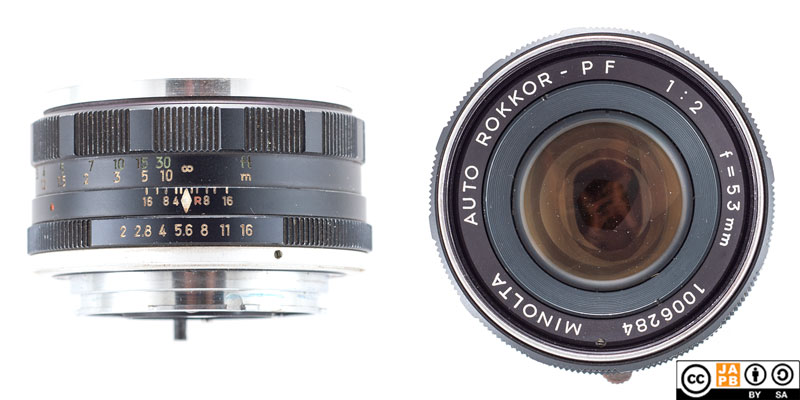Pekka Buttler, 01/2023

Specifications
The table below summarizes the lens’ key specifications (Measurements based on pictured sample):
| Brand: | Minolta | Lens name | MC Auto Rokkor-PF 1:2 f=53mm |
| Focal length(s) 1 | 53 mm | Angle-of-view 2 | 44,4 ° |
| Maximum Aperture | f/2 | In Production | 1964–≈1966 |
| Lens mounts | Minolta SR | Subfamily (if applicable) | AR (II) |
| Length 3 | 32,1 mm | Diameter 4 | 59,8 mm |
| Filter ring diameter | 52 mm | Weight | 182 grams |
| Lens element count | 6 | Lens group count | 5 |
| Aperture blades (S/R/C) 5 | 6 S | Focus throw | 100 ° |
| Minimum focusing distance | ≈53 cms | Maximum magnification | 1:7,9 |
| Has manual aperture ring | YES | Has Manual focus ring | YES |
| Aperture mechanism type | Automatic | Aperture click stops 6 | 2-2.8-4-5.6-8-11-16 |
Further notes:
• This is definitely an oddball lens. Not only is it the only 53 mm focal length lens ever produced by Minolta, 53 mm focal length lenses are not common in the 35 mm photography world. Beside this Minolta, there was one Topcon UV 53 mm lens, and two 53 mm focal length lenses of Soviet manufacture (Helios-103 and Helios-81M).
• Adding to its oddball character, Minolta offered this 53 mm f/2 lens simultaneously with a 55 mm f/2 lens. While this 53 mm was short-lived, its 55 mm cousin lived on.
• My guess is that this lens was offered as a small-and-light alternative (it was 70 grams lighter and 7 mm shorter than any other normal focal length Minoltas)
• The original Minolta D54KB clamp-on lens hood commands a specialty item price (but one may get lucky). Luckily, any normal focal length 52 mm thread mounted hood will do the job nicely.
• Alike many Auto Rokkor lenses, the lens offered a small aperture stop down lever on the outside of the lens.
Versions
This lens was short-lived, and only one variant (introduced in 1964) was ever produced. While there is no hard data on when its production was ended, it was never facelifted to AR C specifications and was never made in an meter-coupled (MC version) (See the JAPB article on the Minolta SR mount for all the details on SR mount versions and generations). Hence, it was certainly discontinued in 1968, but likely already earlier.
Adapting
This lens cannot be used natively on any current SLR or dSLRs. To use it in its native environment, you will need a Minolta SR (SR/MC/MD/X-600) film camera. Luckily these are quite easy to find. To use the lens’ full designed capabilities, a Minolta MD-compatible body (any Minolta SR body launched after 1977) is most recommended..
Thanks to being a fully manual lens (manual aperture, manual focus), the lens can be adapted to all mirrorless cameras using a suitable adapter. Moreover, a simple ‘dumb adapter’ will do the job perfectly. Thanks to the popularity of the Minolta SR mount, the availability of adapters to all mirrorless mounts can be taken for granted, on the other hand, specialist adapters (speed boosters, helicoid adapters, tilt/shift adapters) are not available for all mirrorless mounts, but daisy-chaining adapters (e.g. Minolta SR -> Canon EF; Canon EF –> mirrorless) can offer a work-around.
Using Minolta SR mount lenses on dSLRs is also be an option, but it is not trouble-free due to that the Minolta SR mount’s flange focal distance is shorter than that of any dSLR mount (technically with the exception of Olympus’ four thirds mount). Hence, any attempt at adapting Minolta SR lenses must rely on an adapter that uses corrective optics to allow infinity focus. However, such adapters are readily available.
History of Minolta
Minolta exited the camera business in 2006 and sold its remaining photographic assets to Sony. The 50 years before that ignominious date tell a very different story: one of a Japanese optics and innovation powerhouse that has interesting links to Germany – not Nazi Germany, but both pre WWII Germany as well as postwar West Germany. Read more in the Minolta company profile.
Footnotes
- Focal length is (unless stated otherwise) given in absolute terms, and not in Full-frame equivalent. For an understanding of whether the lens is wide/tele, see ‘Angle-of-view’. ↩︎
- Picture angle is given in degrees (based on manufacturers’ specs) and concerns the diagonal picture angle. Rule of thumb:
> 90 ° ==> Ultra-wide-angle
70–90 ° ==> Wide-angle
50–70 ° ==> Moderate wide-angle
40–50 ° ==> ‘Standard’ or ‘normal’ lens
20–40 ° ==> Short tele lens
10-20 ° ==> Tele lens
5-10 ° ==> Long tele lens
< 5 ° ==> Ultra-tele lens ↩︎ - Length is given from the mount flange to the front of lens at infinity. ↩︎
- Diameter excludes protrusions such as rabbit ears or stop-down levers. ↩︎
- S=straight; R=rounded; C=(almost)circular at all apertures. ↩︎
- Numbers equal aperture values on aperture ring; • intermediate click; – no intermediate click. ↩︎